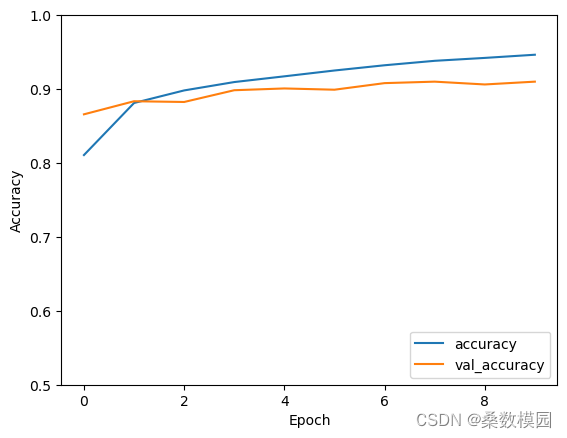文章目录
- 前期工作
- 1. 设置GPU(如果使用的是CPU可以忽略这步)
- 我的环境:
- 2. 导入数据
- 3.归一化
- 4.调整图片格式
- 5. 可视化
- 二、构建CNN网络模型
- 三、编译模型
- 四、训练模型
- 五、预测
- 六、模型评估
前期工作
1. 设置GPU(如果使用的是CPU可以忽略这步)
我的环境:
- 语言环境:Python3.6.5
- 编译器:jupyter notebook
- 深度学习环境:TensorFlow2.4.1
import tensorflow as tf
gpus = tf.config.list_physical_devices("GPU")if gpus:gpu0 = gpus[0] #如果有多个GPU,仅使用第0个GPUtf.config.experimental.set_memory_growth(gpu0, True) #设置GPU显存用量按需使用tf.config.set_visible_devices([gpu0],"GPU")
2. 导入数据
import tensorflow as tf
from tensorflow.keras import datasets, layers, models
import matplotlib.pyplot as plt(train_images, train_labels), (test_images, test_labels) = datasets.fashion_mnist.load_data()
3.归一化
# 将像素的值标准化至0到1的区间内。
train_images, test_images = train_images / 255.0, test_images / 255.0train_images.shape,test_images.shape,train_labels.shape,test_labels.shape
加载数据集会返回四个 NumPy 数组:- train_images 和 train_labels 数组是训练集,模型用于学习的数据。
- test_images 和 test_labels 数组是测试集,会被用来对模型进行测试。图像是 28x28 的 NumPy 数组,像素值介于 0 到 255 之间。标签是整数数组,介于 0 到 9 之间。这些标签对应于图像所代表的服装类:
| 标签 | 类 | 标签 | 类 |
|---|---|---|---|
| 0 | T恤/上衣 | 5 | 凉鞋 |
| 1 | 裤子 | 6 | 衬衫 |
| 2 | 套头衫 | 7 | 运动鞋 |
| 3 | 连衣裙 | 8 | 包 |
| 4 | 外套 | 9 | 短靴 |
4.调整图片格式
#调整数据到我们需要的格式
train_images = train_images.reshape((60000, 28, 28, 1))
test_images = test_images.reshape((10000, 28, 28, 1))train_images.shape,test_images.shape,train_labels.shape,test_labels.shape
5. 可视化
class_names = ['T-shirt/top', 'Trouser', 'Pullover', 'Dress', 'Coat','Sandal', 'Shirt', 'Sneaker', 'Bag', 'Ankle boot']plt.figure(figsize=(20,10))
for i in range(20):plt.subplot(5,10,i+1)plt.xticks([])plt.yticks([])plt.grid(False)plt.imshow(train_images[i], cmap=plt.cm.binary)plt.xlabel(class_names[train_labels[i]])
plt.show()

二、构建CNN网络模型
卷积神经网络(CNN)的输入是张量 (Tensor) 形式的 (image_height, image_width, color_channels),包含了图像高度、宽度及颜色信息。不需要输入batch size。color_channels 为 (R,G,B) 分别对应 RGB 的三个颜色通道(color channel)。在此示例中,我们的 CNN 输入,fashion_mnist 数据集中的图片,形状是 (28, 28, 1)即灰度图像。我们需要在声明第一层时将形状赋值给参数input_shape。
model = models.Sequential([layers.Conv2D(32, (3, 3), activation='relu', input_shape=(28, 28, 1)), #卷积层1,卷积核3*3layers.MaxPooling2D((2, 2)), #池化层1,2*2采样layers.Conv2D(64, (3, 3), activation='relu'), #卷积层2,卷积核3*3layers.MaxPooling2D((2, 2)), #池化层2,2*2采样layers.Conv2D(64, (3, 3), activation='relu'), #卷积层3,卷积核3*3layers.Flatten(), #Flatten层,连接卷积层与全连接层layers.Dense(64, activation='relu'), #全连接层,特征进一步提取layers.Dense(10) #输出层,输出预期结果
])model.summary() # 打印网络结构
Model: "sequential"
_________________________________________________________________
Layer (type) Output Shape Param #
=================================================================
conv2d (Conv2D) (None, 26, 26, 32) 320
_________________________________________________________________
max_pooling2d (MaxPooling2D) (None, 13, 13, 32) 0
_________________________________________________________________
conv2d_1 (Conv2D) (None, 11, 11, 64) 18496
_________________________________________________________________
max_pooling2d_1 (MaxPooling2 (None, 5, 5, 64) 0
_________________________________________________________________
conv2d_2 (Conv2D) (None, 3, 3, 64) 36928
_________________________________________________________________
flatten (Flatten) (None, 576) 0
_________________________________________________________________
dense (Dense) (None, 64) 36928
_________________________________________________________________
dense_1 (Dense) (None, 10) 650
=================================================================
Total params: 93,322
Trainable params: 93,322
Non-trainable params: 0
_________________________________________________________________

三、编译模型
在准备对模型进行训练之前,还需要再对其进行一些设置。以下内容是在模型的编译步骤中添加的:
- 损失函数(loss):用于测量模型在训练期间的准确率。您会希望最小化此函数,以便将模型“引导”到正确的方向上。
- 优化器(optimizer):决定模型如何根据其看到的数据和自身的损失函数进行更新。
- 指标(metrics):用于监控训练和测试步骤。以下示例使用了准确率,即被正确分类的图像的比率。
model.compile(optimizer='adam',loss=tf.keras.losses.SparseCategoricalCrossentropy(from_logits=True),metrics=['accuracy'])
四、训练模型
history = model.fit(train_images, train_labels, epochs=10, validation_data=(test_images, test_labels))
Epoch 1/10
1875/1875 [==============================] - 9s 4ms/step - loss: 0.7005 - accuracy: 0.7426 - val_loss: 0.3692 - val_accuracy: 0.8697
Epoch 2/10
1875/1875 [==============================] - 6s 3ms/step - loss: 0.3303 - accuracy: 0.8789 - val_loss: 0.3106 - val_accuracy: 0.8855
Epoch 3/10
1875/1875 [==============================] - 6s 3ms/step - loss: 0.2770 - accuracy: 0.8988 - val_loss: 0.3004 - val_accuracy: 0.8902
Epoch 4/10
1875/1875 [==============================] - 6s 3ms/step - loss: 0.2398 - accuracy: 0.9097 - val_loss: 0.2898 - val_accuracy: 0.8968
Epoch 5/10
1875/1875 [==============================] - 6s 3ms/step - loss: 0.2191 - accuracy: 0.9195 - val_loss: 0.2657 - val_accuracy: 0.9057
Epoch 6/10
1875/1875 [==============================] - 6s 3ms/step - loss: 0.1952 - accuracy: 0.9292 - val_loss: 0.2731 - val_accuracy: 0.9036
Epoch 7/10
1875/1875 [==============================] - 6s 3ms/step - loss: 0.1791 - accuracy: 0.9322 - val_loss: 0.2747 - val_accuracy: 0.9056
Epoch 8/10
1875/1875 [==============================] - 6s 3ms/step - loss: 0.1576 - accuracy: 0.9416 - val_loss: 0.2750 - val_accuracy: 0.9049
Epoch 9/10
1875/1875 [==============================] - 6s 3ms/step - loss: 0.1421 - accuracy: 0.9461 - val_loss: 0.2876 - val_accuracy: 0.9032
Epoch 10/10
1875/1875 [==============================] - 6s 3ms/step - loss: 0.1330 - accuracy: 0.9509 - val_loss: 0.2769 - val_accuracy: 0.9144
五、预测
预测结果是一个包含 10 个数字的数组。它们代表模型对 10 种不同服装中每种服装!的“置信度”。我们可以看到哪个标签的置信度值最大
plt.imshow(test_images[10])

import numpy as nppre = model.predict(test_images)
print(class_names[np.argmax(pre[10])])
313/313 [==============================] - 1s 2ms/step
Coat
六、模型评估
plt.plot(history.history['accuracy'], label='accuracy')
plt.plot(history.history['val_accuracy'], label = 'val_accuracy')
plt.xlabel('Epoch')
plt.ylabel('Accuracy')
plt.ylim([0.5, 1])
plt.legend(loc='lower right')
plt.show()test_loss, test_acc = model.evaluate(test_images, test_labels, verbose=2)

print("测试准确率为:",test_acc)
0.7166000008583069

)
——设置WebGL发布时每张图片的压缩方式)





)



:哈希算法在分布式系统中有哪些应用?)






